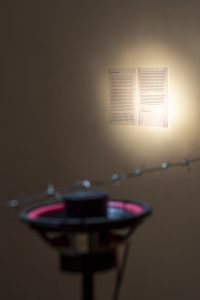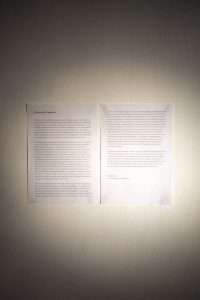The Sound of Vanquishers – On “Sculpted Sonorities” at Errant Sound
|
We find ourselves in an era often regarded as one of the best times to live, with approximately one-third of humanity residing under political democracies. With access to technologies that soften the misery of the human condition, we have more space for expression, communal safety mechanisms that protect us as individuals in turbulent times, and most importantly, a great deal of information about ourselves and our environment. Yet, these advancements exist against the backdrop of brutal wars and ecocides. We witness our primal violent tendencies persisting in territorial conflicts, even as we contemplate the human condition as one of peace and productivity. Despite this, we continue to hope for a better future.
The human capacity expanding on a broad horizon with antithetical elements also manifests itself in how we make use of instruments, and actually, how we develop them in the first place. The shapeshifting qualities of metals have enabled humans to mould them into instruments with paradoxical, and at times coexisting, purposes. Choosing to employ these instruments for the betterment of society is a decision we confront daily. Unfortunately, some of these instruments were and are tools of mass destruction, or were/are used for such purposes, their primary function is not being such. Moreover, the need for collective action for violent purposes has contributed to the development of our tool-making skills as well. Early humans learned to communicate through various sounds to act collectively during hunts and wars. Communal routines and rhythms emerged through collective action, primarily driven by survival instincts and vicious purposes. While it is conceivable that poetry and music coexisted with battle cries for a long time, the reality that the sounds we hear today are echoes of those who preferred the latter over the former is a sobering truth. It does not bridge with what we are trying to make of humanity. It is hard to accept that our history is imbued with bloody wars, genocides and ecocides as we try to imagine a world where life is protected at all costs and flourished in its own form.
I believe accepting the dual nature of the human condition is a first step towards digressing from a Social Darwinist perspective and curbing the undesirable parts of our nature, namely the capacity for violence. Investigating this paradox through a study of human familiarity with ores, Özcan Ertek plays with the multifunctionality embedded in metal atoms and recreates historical soundscapes through the use of metal objects. Investigating this paradox through a study of human’s familiarity with ores, Özcan Ertek plays with the multifunctionality embedded in metal atoms and recreates historical soundscapes drawing on auditory experience-memories.In his Bells and Cannons, he points to the memory of the First World War, a turbulent time when the church bells that had tolled for civic purposes for centuries were casted into cannons. Focusing on this particular historical transformation, the sculpture presents a sublime soundscape with heavy sounds. Similarly, the Devil’s Rope presented in the exhibition centres around the barbed wire as a paradoxical tool. Referring to the removal of indigenous people of the Americas, he reminds us how the same tool colonizers utilized for territorial invasion was also utilized for communication in the following period. The work’s title glimpses into how indigenous people perceived those barbed wires. Barbed wires were spiked with thorns that kept the native animals away and provided ample space for alien species, resulting in the terraforming of vast meadows into pasturage and the destruction of ecosystems. These long lines of fences that partitioned land also acted as a landline among neighbours after the invention of the telephone. By tapping into the line with a device converting electrical signals into acoustic vibrations, they could talk to someone in the distance! Das Loop, the second work in the exhibition, sums up his approach to spatial perception and sound in an abstract fashion. It invites the visitors to get closer to the materiality of metals by amplifying the sounds in a manner bridging the distance between the ear and the metal chips. The malleable and resonating aspects of metal act as a metaphor for the human capacity for chaos and order, which also triggers the closing remark/question: Will we ever be able to grind down our brutal aspects and put our shiny metals into the service of the betterment of society by casting them into medicinal and communication tools? Oğuzhan İzmir
|



